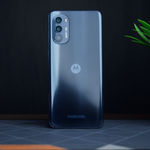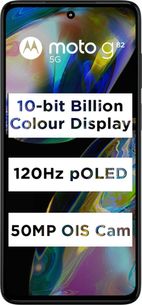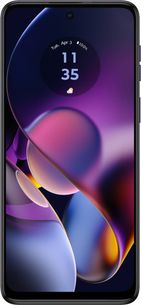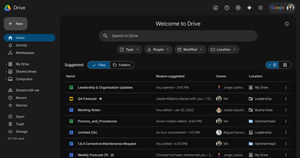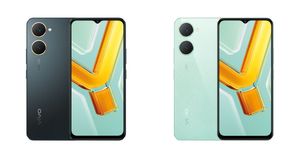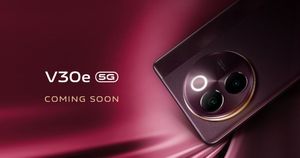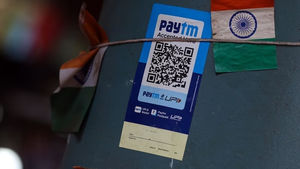
The Moto G82 is Motorola’s attempt at making a course correction in the market, which has become full of performance-centric slabs of glass. Launched recently at Rs. 21,499, the phone boasts a 10-bit pOLED panel at the front with a refresh rate of 120Hz. It is strongly pitted against the Redmi Note 11 Pro+ and Realme 9 Pro+.
We raved about the Moto G82’s display in our first impressions, but now it’s time to put it to the test and see how the rest of its package works out. Find out in our review whether it should be your pick for the next phone you buy.
Moto G82 Review: Design and build
The Moto G82 looks Motorola-ish unmistakably. It sports a curved rear panel, a rounded camera module and a chamfered frame. The rear is made of acrylic glass or ‘glasstic’ as some people call it. It is quick to catch scratches, but it helps shave off a few grams and keep the phone slim.
But here’s the thing – Motorola has been boiling the pot of this design language for quite some time now, and it is starting to look a bit dated.
Coming to grilles and ports, the top of the phone has a few cutouts for a mic and lanyard, the left has a SIM tray, whereas the bottom has a USB Type-C port, a 3.5mm headphone jack, mic hole and a speaker grille. The right of the phone hosts the volume rocker and lock button with an embedded fingerprint reader.
The in-hand feel of it is good, though, but the same can’t be said for the button placement. We feel it was a terrible idea to place the tiny volume rocker so high up on the right with such little tactile feedback. The lock button is also placed in a weird spot where your palm keeps touching it. The annoying thing is it keeps triggering the double-tap gesture on the reader while texting, which brings down a quick app access menu. It can be irritating.
 The Moto G82 is also IP52-certified for dust and mild water resistance, so it’ll be fine dealing with a few splashes.
The Moto G82 is also IP52-certified for dust and mild water resistance, so it’ll be fine dealing with a few splashes.
Moto G82 Review: Display
Gracing the front of the smartphone is a gorgeous 6.6-inch pOLED display that refreshes at 120Hz. Thanks to the touch sampling rate of 360Hz, your touch inputs feel extremely cohesive on display. Thanks to the 10-bit colour depth and Full HD+ resolution, everything appears crisp and vibrant on it. Further, it has DC dimming, which avoids eye strain when using the phone at low brightness late at night, and it is also capable of reproducing a DCI-P3 wide colour gamut.

Overall, our experience with the display has remained unchanged – it is an absolute joy to use, and the brightness and viewing angles are also very good. Not a lot of smartphones in this price category offer such a beautiful display.
The display also gives you a perception of speed, despite the phone lacking a cutting edge SoC.
The display is accompanied by a pair of Dolby Atmos-compliant stereo speakers. The physical output of these is slightly feeble to my taste, and maxing out the volume can cause a bit of crackling. Also, for some reason, the loudness of calls on speakers was way too low despite maxing out on volume on the screen.
The bottom speaker grille can be easily muffled while playing games, but the other speaker is loud enough to compensate.
Overall, we are still very much impressed by the display of this phone, and if you’re a binge-watcher, it’ll be hard for you to look elsewhere at this price.
Moto G82 Review: Performance
To maintain the delicate balance of including such a capable display and keeping the price low, Motorola had to resort to a rather lower-spec SoC. The Qualcomm Snapdragon 695 powers this phone, which is paired with two RAM variants of 6GB and 8GB. The internal storage is constant at 128GB, but you get 1TB of expandable storage via a hybrid SIM slot.
Running this hardware is Android 12 with Motorola’s My UX skin. There’s no bloat whatsoever, except the pre-installed Facebook and Dolby Atmos app, along with some Moto Gestures. It is, at least in our regard, one of the best renditions of Android, and it feels extremely smooth to use. No funky advertisements or push notifications are bothering you, just a simple, near-stock Android experience.
The overall performance, however, is mediocre at best. We could get through most of our day without complaining much with light to medium usage, but the moment we started multitasking with Google Maps and YouTube Premium running in the background, the phone started gasping for breath.
We would recommend going gentle with the phone because even though it doesn’t regularly heat up, medium usage with GPS-intensive apps can take the temperatures for a ride.
In terms of benchmark figures, the phone posted a cumulative score of 332047 in AnTuTu 9, which puts it up against some of the mainstream phones of 2018. On GeekBench 6, the phone managed to churn out a single-core score of 487 and a multi-core score of 1512, which is nothing special.
However, gaming wasn’t unpleasant at all. I had set my expectations low, but in Call of Duty: Mobile, the Moto G82 was able to game consistently without any frame drops at High graphics and Max frame rate settings. The heat generated during the process was also very low, and the phone lost about 4% battery in 20 minutes of gaming. The touch inputs were also satisfactory.
Moto G82 Review: Battery
The Moto G82 is backed by a 5,000mAh battery, which was massive a year ago, but now, a lot of smartphones have started defaulting to it. The 33W Turbopower charger complements this.
The battery backup is decent, we were able to churn out 8-9 hours of screen-on time with the phone, which is impressive given how much of a battery hog that display could have been. The phone can last a day and a half on a single charge, so it holds its weight against the competition in this regard.
The 33W charging can be one of the deal-breakers for the phone. It takes about one hour and 10 minutes to charge the phone entirely, which isn’t a bad number, but the competition has started providing 60W charging in the price range.
Moto G82 Review: Camera
 We may sound harsh before we even start talking about the camera of the Moto G82, but it is the Achilles heel of the entire package. On paper, the specs seem acceptable – we have optically stabilised 50-megapixel primary, 8-megapixel ultrawide and 2-megapixel macro cameras. But in reality, the camera system just can’t deliver.
We may sound harsh before we even start talking about the camera of the Moto G82, but it is the Achilles heel of the entire package. On paper, the specs seem acceptable – we have optically stabilised 50-megapixel primary, 8-megapixel ultrawide and 2-megapixel macro cameras. But in reality, the camera system just can’t deliver.
During the day, the shots taken by the primary camera were exposed nicely with a neutral colour tone but lacked details. The objects at a distance appeared unclear, almost as if they were painted with watercolour. HDR kicks in automatically, but not that aggressively.
The ultrawide camera has a really wide field of view, so it helps you pack more material in your frame. The distortion around the corners is surprisingly low, but again, photos clicked with it lack details.
We tried the macro camera for fun, and the output was as we expected – soft photos that are barely usable.
Night shots disappointed us the most. We haven’t seen so much noise in a smartphone camera’s low light shot since 2018, and it is the dirtier kind of noise where red dots are visible despite using the night vision mode.
Indoor shots came out fine, and so did the portraits. Selfies were not overly beautified, but they did have a bit of noise when clicked indoors, even with good lighting.
Video recordings are capped at 1080p/60fps for the primary and 1080p/30fps for the ultrawide. The lack of any 4K recording options really stumps us. The output from the primary camera is optically stabilised, whereas the feed coming from the ultrawide is electronically stabilised. Videos taken from the primary camera are cropped in a bit too much, and the ultrawide recordings don’t pack much detail. The recordings can be used if you’re shooting something for reference, just don’t expect to be shooting high-quality reels with it.
Having said that, the camera interface is intuitive, quick and offers just enough features that don’t overwhelm the user. So apart from the regular modes, you have a Pro mode, spot colour mode, a dual capture and spot colour mode. The shutter lag is also minimal in decently-lit shots.
Moto G82 Review: Verdict
The Moto G82 delivers what it advertises – a binge-worthy display, good battery life, decent performance and a fantastic UI. This may start a new trend of high quality displays trickling down to the sub-Rs 25,000 segment. However, optics aren’t the stronghold of the G82, and the 33W charging may also bother some people considering buying this phone. If these are your priorities, do check out the Realme 9 Pro+, which also offers superior performance.
